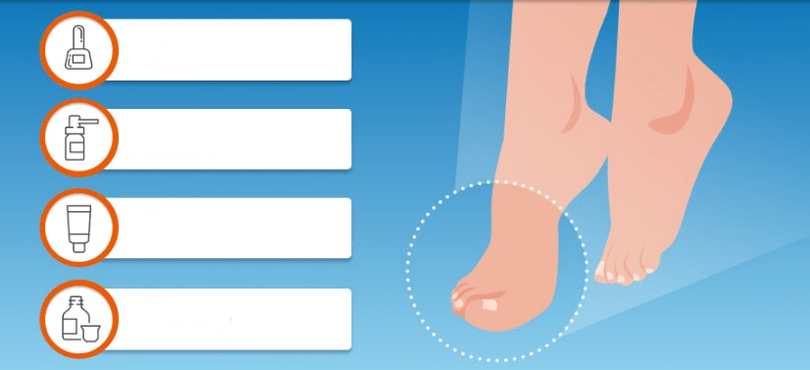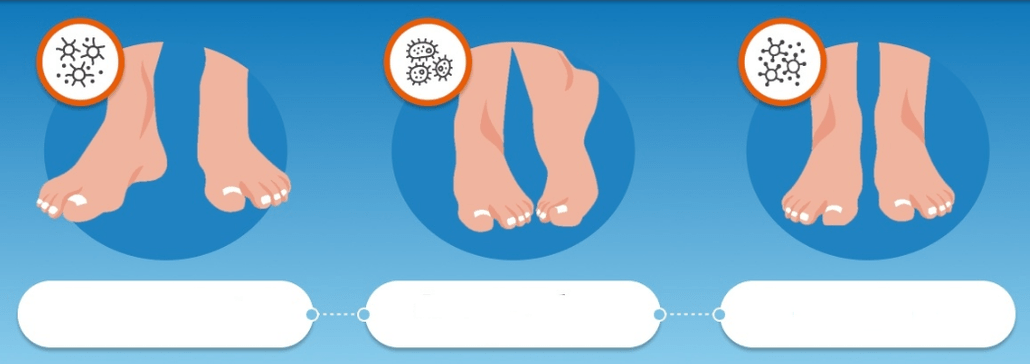Nail fungus (onychomycosis) is diagnosed in an average of 10-15% of the world's population, with an incidence of 30-50% in people over the age of 60. Men suffer 1. 3 times more than women, which may be due to a lack of responsible attitude towards the problem. Removing onychomycosis is difficult, but it is possible, and the main task of the doctor and the patient is to choose the right remedy for nail fungus. We talk about what drugs are and how they work.
Does the fungus need treatment?
Many people, especially older men, ignore fungal treatments, believing the problem is just an aesthetic problem with no consequences other than cosmetic defects. This is a very dangerous misunderstanding. We explain why.
First, fungi are extremely contagious. The infection can spread quickly if not treated carefully. The pathogen of onychomycosis is easily spread through household items, and patients are at risk of infecting the entire family.
Second (and most important), the problem of nail fungus is much more than cosmetic. A neglected disease can significantly reduce quality of life: pain, difficulty choosing shoes, and various household inconveniences. Nail plates affected by fungus can collapse over time. But that's still half the trouble. Without prompt and proper treatment, onychomycosis can damage the entire body. There is an increased risk of allergy (due to hypersensitivity to fungi and their metabolites), and infectious complications are often added (eg, erysipelas). Any skin disease is more serious in the context of onychomycosis. Not to mention that chronic infections can weaken the immune system.
So the answer is clear: it is necessary to treat nail fungus, and as soon as possible. The deeper the process goes, the harder it is to get rid of the disease. Therefore, ideally, treatment should begin at the first sign of injury. Another question is how to treat it. There are so many types of drugs, it's easy to get confused. But you need to know how they work in order to know which remedies will help get rid of nail fungus. We will talk about this.
Choosing a Medicine for Nail Fungus
You can find a lot of advice on fighting fungus online. Traditional medicine recommends getting rid of it with the help of soda water, ammonia, propolis, kerosene, celandine juice, essential oils. Recipe for nail fungus treatment with vinegar, iodine, hydrogen peroxide. By resorting to this seemingly innocuous home approach, patients only exacerbate the problem. No traditional medicine can destroy the causative agent of onychomycosis, and the lesions progress, covering an increasing area of the nail plate. In the end, the patient ended up in a dermatologist's office with an advanced fungus that was difficult to treat.
So advice number one - don't self-medicate! If signs of the disease are found, it is necessary to contact a dermatologist, who will prescribe an effective drug for nail fungus. Self-medication is not acceptable because onychomycosis is caused by different types of pathogens and it is important to choose the right active ingredient in each case. In order not to doubt the advice of experts, it is necessary to understand how they work and the differences between the drugs used to treat this disease.
The means used to treat nail fungus can be classified according to release form and active ingredient. Among other selection criteria, price category and ease of use are important.
Post form
External preparations against nail fungus are produced in the form of varnishes, sprays, creams (ointments) and solutions.

AntifungalVarnish, as a rule, women prefer because with the help of these products it is possible to combine treatment with beauty care. The surface of the nail plate needs to be polished with a file before processing. After applying the medical varnish, you can use the trim. This is the main advantage of this dosage form.
However, varnishes are not universal. First, they only work on small areas of damage. If the fungus has spread to more than one-third of the nail plate, remedies will not help. Secondly, drugs in the form of varnishes can only deal with superficial fungal diseases. This is because it cannot penetrate the lower layers of the nail. For deep lesions, when the nail plate thickens, antifungal agents in the form of nail polish will not work - stronger medications are required.
Cream and Spray- Similar form: Both have oil base. They are ideal for treating dermatophytes, which, by the way, are often accompanied by nail fungus. The tool easily penetrates the lower layers of the epidermis and destroys pathogens. But the nail structure is denser, and oily preparations cannot reach all infected sites. Creams or sprays are best used as an adjunct to the treatment of onychomycosis - the fungal infection that accompanies the skin of the feet.
solution- The best form of nail antifungal. The water-alcohol-based drug penetrates deep into the nail plate, filling the voids and channels through which pathogens can spread. Therefore, the bactericidal and bacteriostatic effect of nail fungus liquid is stronger than other forms.
active substance
Antifungal agents are mainly substances of synthetic (rarely natural) origin, with diverse chemical structures. Depending on it, they differ in their range of activity, i. e. their action against certain pathogens. Given that onychomycosis can be caused by different types of pathogenic fungi, the correct selection of active substances is important.

notes
To reliably determine the type of pathogen, microbiological studies of tissue fragments are necessary. But usually you can determine the type of fungus by the external features of the affected nail. The most common causative agent of onychomycosis is Trichophyton rubrum. Less commonly, the disease is caused by other types of dermatophytes, yeast-like, and mold fungi.
In terms of chemical structure, there are several groups of antifungal drugs:
Polina. These include substances such as nystatin, levomycin, amphotericin. When taken orally, they are active against many types of fungi, but topical application of these drugs is only effective against candidiasis. Therefore, polyenes are generally not used to treat onychomycosis.
azoles. For external use, use drugs based on the substances clotrimazole, econazole, miconazole, oxyconazole, isoconazole, bifonazole. They work primarily by inhibiting the fungus -- in other words, the drugs stop the fungus from developing. When substances in tissues reach high concentrations, they may have a bactericidal effect (destroy pathogens). The azoles are active against Candida yeasts and skin molds that cause skin damage. For onychomycosis, these drugs are not very effective.
Allylamine. This is the main group of antifungal agents used to treat skin and nail mycosis. For topical use, products based on terbinafine and naftifine are suitable. The first is also prescribed orally in late stages of the disease. Naftifine is an effective treatment for onychomycosis. It has bactericidal activity against dermatophytes (including Trichophyton rubrum), yeasts and molds - in short, the main likely pathogens of fungal nail infections. In addition, naftifine acts on many bacteria.
Among other substances not included in these groups, amorolfine and ciclopirox are used to treat onychomycosis. Both drugs are applied topically, primarily as part of an antifungal varnish.
easy to use
Getting rid of fungus is a long process. After a few months, nail treatment will become a daily routine, otherwise there will be no positive results. Considering the duration of treatment, it is important to choose a tool that is easy to use. In the case of varnishes, it should be remembered that the nail surface must be smoothed before each application. So it's good if there are disposable files in the kit. In the case of a solution, it is better to choose products that are packaged in airtight bottles with dropper stoppers. The elongated nose of the dropper facilitates dispensing of the solution, which penetrates deep into the nail plate. Dosing in this form is optimal: it is easy to measure and apply the required amount of drug, which makes consumption more economical.
Packaging and course fees
Treatment of the fungus should continue until the healthy nail plate has fully grown. For onychomycosis of the hands, the process takes about four months. Toenails grow more slowly on toenails and can take up to a year to heal. So buying antifungal agents is not a one-time expense, but a recurring expense, and of course I want to keep it as low as possible. However, the desire to save should not be exceeded: the main selection criterion is efficiency. A reasonable decision is to focus on the active substance. Sometimes this makes it possible to choose an analog of a widely advertised drug that works just as well but is more lucratively priced.
Onychomycosis not only reduces quality of life, but can also cause serious complications. Therefore, when the first signs of infection are detected, it is necessary to consult a doctor and start treatment as soon as possible.Clinically proven medication for toenail and fingernail fungus.
Solutions for Nail Fungus
To fight nail fungus, you can use the drug in solution. The active ingredient of the drug is naftifine, a substance from the allylamine group that is active against most types of pathogenic fungi. It destroys dermatophytes (Trichophyton, Epidermophyton, Microsporum), Candida yeast, Aspergillus and other types of nail and skin fungal pathogens. The drug in solution penetrates the thickness of the nail plate, travels along the fungus's propagation path, and produces a stable drug concentration in the infection cluster.
The action of the drug is bactericidal, that is, it not only prevents the development of the fungus, but also destroys it.
In addition, naftifine has antibacterial activity. Fungal diseases of the nails and skin are often complicated by bacterial infections, and the use of this drug can solve both problems at the same time.
Another effect of naftifine is anti-inflammatory. It helps reduce the redness, swelling, and itching that often accompany fungal infections.
Indications for the use of this solution include not only fungal infections of the nail plate, but also fungal infections of smooth skin, skin folds and interdigital lesions, as well as candidiasis, pityriasis versicolor, inflammatory dermatomycosis. The range of indications is the same for the other products of the series - cream and spray.
























